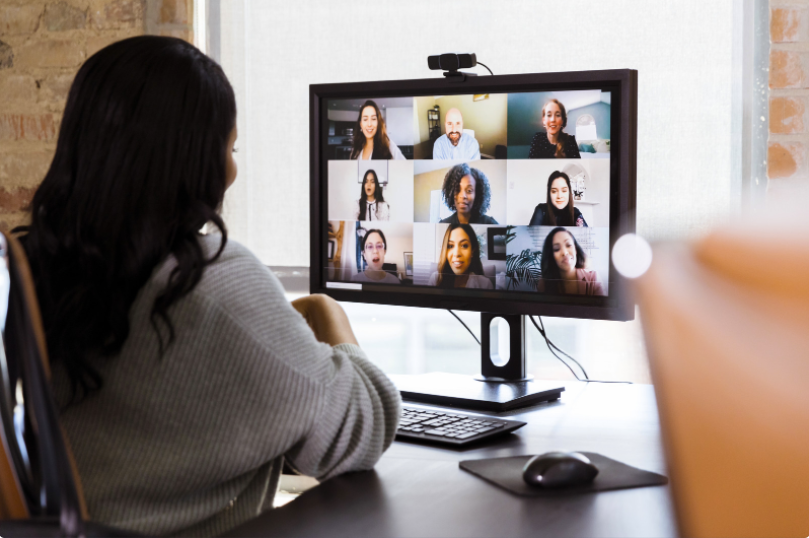Have you ever confidently delivered content for a virtual training session, webinar, or online meeting only to see a participant drop off? Or, have you bravely launched breakout sessions but found that participants got lost on where to go? In this blog article, we discuss how to avoid pitfalls when preparing the online meeting technology for your virtual live training.
This blog article summarizes the main points from a LinkedIn Live talk about how to master the technology to engage participants with Kassy LaBorie (Virtual Classroom Master Trainer | Blog Virtual Hero Trainer Tips) and Barbara Covarrubias Venegas (Founder #virtualspacehero).

Kassy LaBorie – founder and principal consultant at Kassy LaBorie Consulting, LLC.
As a virtual classroom master trainer, she is coaching trainers to be engaging and effective when facilitating programs in several platforms like Zoom, WebEx, Adobe Connect. Kassy has worked with many Fortune 500 firms in several industries and sectors. Including hospitality, pharma, energy, government, NGOs, non-profits.
In addition, she trains producers as well as instructional designers needing to create or convert content for virtual classroom delivery.
In short, Kassy has over 20 years of experience in helping organizations, learning teams, and training professionals successfully move to the virtual environment.
How to prepare the online meeting technology and content beforehand to run everything smoothly?
When preparing a virtual event there are two main areas that you need to consider. Firstly the technology and content need to be prepared, which will be discussed in this section. What is often forgotten, however, is that also the participants need to be prepared. How that can be done, will be elaborated on in the next section of the article.
Choose which online meeting technology/platform you want to use and understand how it works
Lately, the choice of available virtual platforms with completely different features has been constantly growing. That means: Choosing the right one for your event is becoming increasingly critical. Why? Well, depending on which platform you use, the content is stored and brought across differently. Meaning that it has a huge impact on content design and the management of trainers and producers, as they need to keep different things in mind.
“When I need to plan a smaller session that will only go for an hour, I personally rather stick to the chat function because I know that the majority of the participants will be able to manage that. In my experience, participants tend to struggle with more complicated tools like the annotation one, for example.” (Barbara Covarrubias Venegas)
Kassy divides online platforms into two big categories which will be explained below:
1️⃣ Revealers
Any platform where the session can be planned and created beforehand, but the content is revealed only during the session, is a revealer type platform. For the planning process, this means a lot of flexibility and the possibility to be creative on the one hand, but on the other hand, it means additional stress, especially if there is no producer. When working with such platforms, like Zoom, for example, it needs to be made sure that the content is easily accessible for the trainer and/or producer once the event has started. A folder on the desktop of the PC you are working with, with the different slides or activities in the planned order, would be an example of how this could be achieved.
2️⃣ Builders
On the other end of the spectrum are platforms like Adobe Connect that allow you to upload the entire material months in advance. Sometimes the created sessions can even be turned into templates and be reused over and over again. Using such platforms reduces stress but limits flexibility in content. To maintain flexibility, Kassy recommends using the slides as a canvas or map rather than putting the entire content on them. Images can be used as reminders where for example polls or breakout rooms are planned.
How can we prepare attendees to participate before the session?
Without the proper preparation of the participants, it will get hard to impossible to reach the set goals for the event. This holds especially true for bigger conferences that go over a few days. Kassy gave a few tips on what to do and what not to do to achieve that during the LinkedIn Live.
❌Do not rely on scripts or videos that are sent out to the participants beforehand
Yes, they can be helpful and a small number of participants will read/watch them, but it usually doesn’t have any practical value, as the features that they read about/see being used cannot be tried out.
✔️ Plan a short kick-off before the event instead
Of course, this is not necessary for one-time events that will last only an hour. For bigger events or longer learning journeys, however, it can be very beneficial to plan a short kick-off event. It doesn’t have to be longer than 30 minutes, but it’s a great way to have the participants try out all the features that they will need to use during the event. For example, the chat, the whiteboard, or the annotation tool. The event will run smoother, because everyone is familiar with the used online meeting technology. Now you can invest your time in building relationships among participants. Another possibility is to use the first 10 minutes when getting to know each other to explore the functions you will use – by integrating content, agenda, icebreaker with technical onboarding.
✔️ Let the participants know what they will need BEFOREHAND
Downloading any online meeting technology, like files or apps can take a lot of time during an event. Especially if it is not clear to the participants how they need to do it. To avoid that, it can be beneficial to let the participants know during the kick-off event, which files or additional apps they will need to have access to during the event. This way they can prepare everything beforehand and no time is wasted during the event for these technical/admin aspects.
✔️ Keep online meeting technology simple
The number of participants and the required content will determine if and how many external applications to use during the event. However, most platforms already offer functions like whiteboards or polls or at least simplistic versions of them, like the green tick or red cross. This allows you to keep the additional effort (for you and the participants to a minimum). If we are honest, nobody likes logging into 10 different sites simultaneously, particularly if they all are hard to navigate and require previously acquired knowledge.
“I am a fan of platforms that have a lot of options in regards to tools, rather than being expected to use external apps. It allows me to keep things simple for the participants and to focus on the what rather than on the how.”
How can we build successful virtual working relationships with presenters?
The most important pillar in the relationship between presenters and between presenters and producers is the ability to give and accept feedback. Working on this pilar happens mainly through creating trust and rehearsals.
1️⃣ Creating trust
Creating trust might sound easy, but it certainly is not. Especially in the virtual space where there is no face-to-face contact. Making a conscious effort to get to know each other personally can work wonders here.
But read more about creating trust and how to shape meaningful interactions in virtual teams on our #virtualspacehero blog!
2️⃣ Rehearsals
Rehearsals are not only important for a smooth event. During rehearsals, instructions and feedback are given where needed. Getting used to taking instructions, which might come off as a little rude in stressful situations is very important. If one is confronted with that for the first time during the actual event, it can lead to tensions between the presenters or somebody might even get offended.
The main takeaway from this post should be that not only the time of the event is important but that the right preparation, especially of online meeting tools, is sometimes as important. So before organizing the next event, take your time to think everything through and we definitely recommend to read through some of our other blog articles and become a #virtualspacehero.


 Want to read more from Kassy about Virtual Training?
Want to read more from Kassy about Virtual Training?

